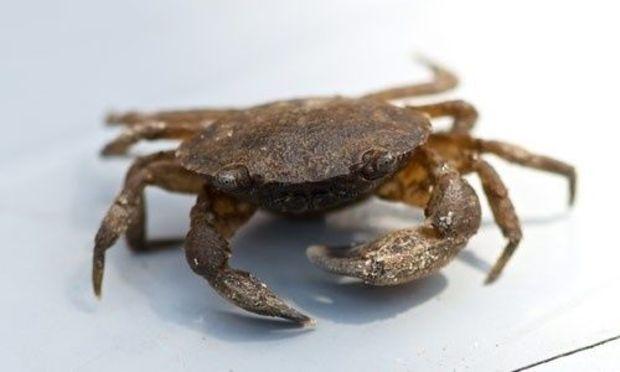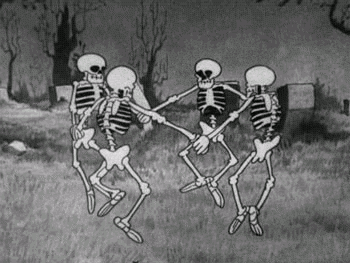Just in time for Halloween!
Zombies. Something out of a science fiction novel, right? Well, for the black-fingered (Atlantic) mud crab, they must seem very real.

According to the
Smithsonian Environmental Research Center (SERC): the parasite
Loxothylacus panopaei, or loxo, is a type of barnacle with a highly evolved life cycle. Female larva infect recently molted crabs by burying into the carapace and assuming control over the host crab. After a time Loxo grows into a reproducing adult and forms small sacs that emerge through the abdomen of the crab. The sacs are filled with thousands of larvae that are released into the water to seek out a new crab host. This process eliminates the crab’s ability to reproduce and tricks the crab into caring for the developing larvae of the parasite.
Luckily, not all mud crabs can be infected by Loxo. Some crabs have a genetic disposition that allows them to fight off the parasite, and the number of infected crabs in the Bay has decreased in recent years.
The video below describes a similar parasite.
https://youtu.be/R_nP4SK_Mno
Loxo was first discovered in the Chesapeake Bay during the 1960s, and is believed to have been introduced when oysters from the Gulf of Mexico were transplanted to seed commercial oyster harvests in the Bay.
To better understand this phenomenon, SERC developed the
Chesapeake Bay Parasite Project. It is a citizen science endeavor, with volunteers able to hand-collect crabs from habitat collectors that sit underwater. Back in the laboratory, SERC staff measure, sex, and examine the crabs for outward signs of the Loxo parasite. Each summer for the last 11 years, crabs and their parasites have been collected from 10 sites in Maryland.
So although human zombies are not yet real... 'zombie' crabs might just be here to stay.
HAPPY HALLOWEEN!

 According to the Smithsonian Environmental Research Center (SERC): the parasite Loxothylacus panopaei, or loxo, is a type of barnacle with a highly evolved life cycle. Female larva infect recently molted crabs by burying into the carapace and assuming control over the host crab. After a time Loxo grows into a reproducing adult and forms small sacs that emerge through the abdomen of the crab. The sacs are filled with thousands of larvae that are released into the water to seek out a new crab host. This process eliminates the crab’s ability to reproduce and tricks the crab into caring for the developing larvae of the parasite.
Luckily, not all mud crabs can be infected by Loxo. Some crabs have a genetic disposition that allows them to fight off the parasite, and the number of infected crabs in the Bay has decreased in recent years.
The video below describes a similar parasite.
https://youtu.be/R_nP4SK_Mno
Loxo was first discovered in the Chesapeake Bay during the 1960s, and is believed to have been introduced when oysters from the Gulf of Mexico were transplanted to seed commercial oyster harvests in the Bay.
To better understand this phenomenon, SERC developed the Chesapeake Bay Parasite Project. It is a citizen science endeavor, with volunteers able to hand-collect crabs from habitat collectors that sit underwater. Back in the laboratory, SERC staff measure, sex, and examine the crabs for outward signs of the Loxo parasite. Each summer for the last 11 years, crabs and their parasites have been collected from 10 sites in Maryland.
So although human zombies are not yet real... 'zombie' crabs might just be here to stay.
HAPPY HALLOWEEN!
According to the Smithsonian Environmental Research Center (SERC): the parasite Loxothylacus panopaei, or loxo, is a type of barnacle with a highly evolved life cycle. Female larva infect recently molted crabs by burying into the carapace and assuming control over the host crab. After a time Loxo grows into a reproducing adult and forms small sacs that emerge through the abdomen of the crab. The sacs are filled with thousands of larvae that are released into the water to seek out a new crab host. This process eliminates the crab’s ability to reproduce and tricks the crab into caring for the developing larvae of the parasite.
Luckily, not all mud crabs can be infected by Loxo. Some crabs have a genetic disposition that allows them to fight off the parasite, and the number of infected crabs in the Bay has decreased in recent years.
The video below describes a similar parasite.
https://youtu.be/R_nP4SK_Mno
Loxo was first discovered in the Chesapeake Bay during the 1960s, and is believed to have been introduced when oysters from the Gulf of Mexico were transplanted to seed commercial oyster harvests in the Bay.
To better understand this phenomenon, SERC developed the Chesapeake Bay Parasite Project. It is a citizen science endeavor, with volunteers able to hand-collect crabs from habitat collectors that sit underwater. Back in the laboratory, SERC staff measure, sex, and examine the crabs for outward signs of the Loxo parasite. Each summer for the last 11 years, crabs and their parasites have been collected from 10 sites in Maryland.
So although human zombies are not yet real... 'zombie' crabs might just be here to stay.
HAPPY HALLOWEEN!
